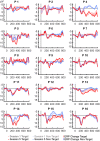Wheelchair Control in a Virtual Environment by Healthy Participants Using a P300-BCI Based on Tactile Stimulation: Training Effects and Usability
- PMID: 32754019
- PMCID: PMC7366506
- DOI: 10.3389/fnhum.2020.00265
Wheelchair Control in a Virtual Environment by Healthy Participants Using a P300-BCI Based on Tactile Stimulation: Training Effects and Usability
Abstract
Tactile stimulation is less frequently used than visual for brain-computer interface (BCI) control, partly because of limitations in speed and accuracy. Non-visual BCI paradigms, however, may be required for patients who struggle with vision dependent BCIs because of a loss of gaze control. With the present study, we attempted to replicate earlier results by Herweg et al. (2016), with several minor adjustments and a focus on training effects and usability. We invited 16 healthy participants and trained them with a 4-class tactile P300-based BCI in five sessions. Their main task was to navigate a virtual wheelchair through a 3D apartment using the BCI. We found significant training effects on information transfer rate (ITR), which increased from a mean of 3.10-9.50 bits/min. Further, both online and offline accuracies significantly increased with training from 65% to 86% and 70% to 95%, respectively. We found only a descriptive increase of P300 amplitudes at Fz and Cz with training. Furthermore, we report subjective data from questionnaires, which indicated a relatively high workload and moderate to high satisfaction. Although our participants have not achieved the same high performance as in the Herweg et al. (2016) study, we provide evidence for training effects on performance with a tactile BCI and confirm the feasibility of the paradigm.
Keywords: P300; brain-computer interface (BCI); event-related-potential (ERP); replication; tactile; tactually evoked potentials; wheelchair control.
Copyright © 2020 Eidel and Kübler.
Figures





References
-
- Allison B. Z., Neuper C. (2010). “Could anyone use a BCI?,” in Brain-Computer Interfaces: Human-Computer Interaction Series, eds Tan S., Nijholt A. (London: Springer; ), 35–54.
LinkOut - more resources
Full Text Sources
Miscellaneous

